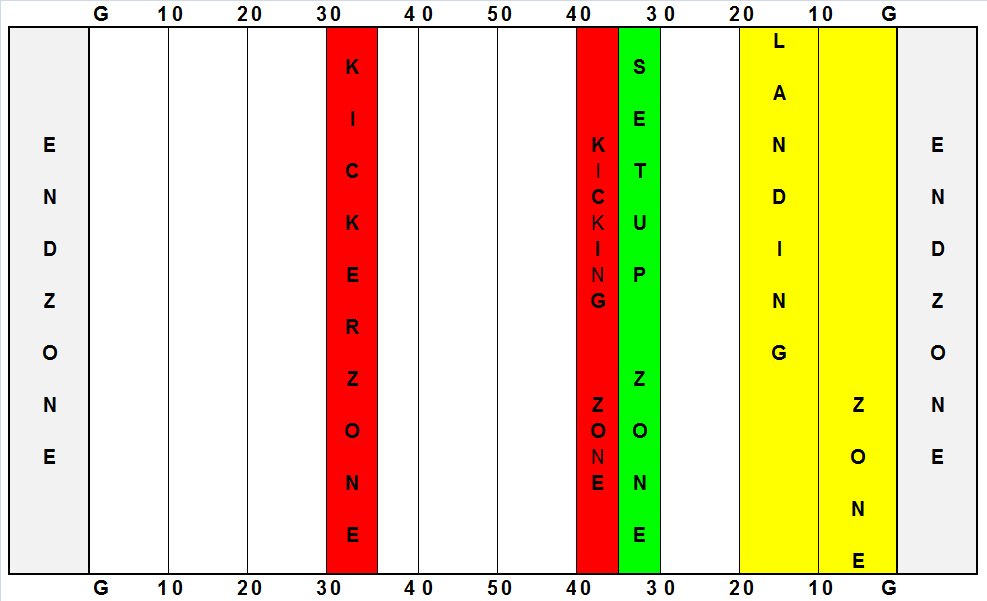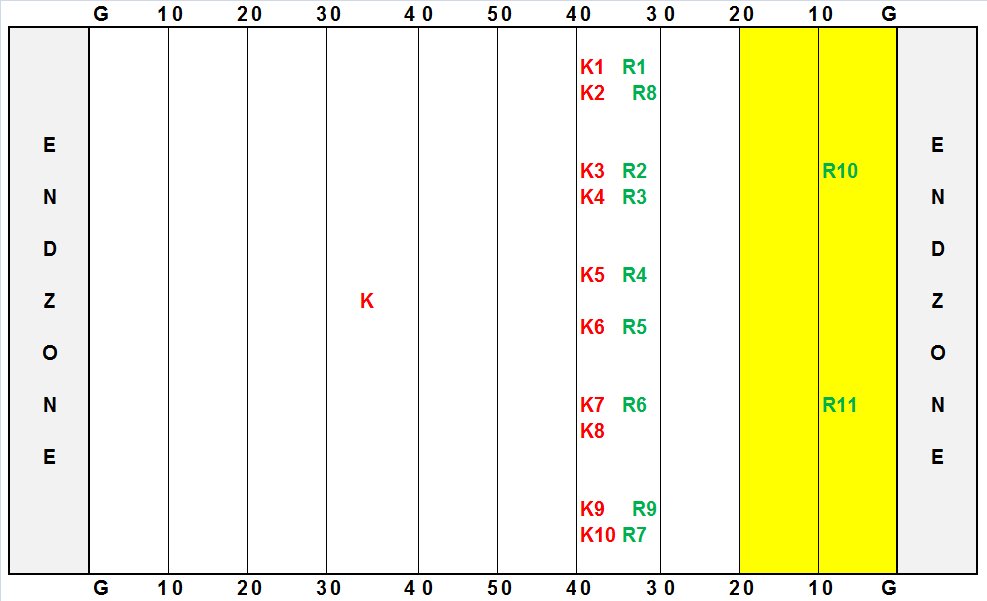NFL kickoff rule changes in the past decade were implemented with player safety as the primary motivator. While they succeeded in large part in that regard, these modifications made kickoffs ineffective and basically useless to the point that the NFL considered removing kickoffs from the game altogether. In addition, the NFL fan base found kickoffs boring and a waste of time.
However, money speaks. And if the kickoff were to be eliminated, network television could lose a commercial break. So, after years of watering down kickoffs for the safety of players, the NFL wants to reinvigorate kickoffs and make them meaningful again while maintaining the level of safety they have achieved. Enter the new kickoff rule changes for 2024, which exist on a one-year trial basis.
Before I get into the new kickoff rule changes for the coming season, I want to share some stats from the last decade that the NFL clearly considered problematic. In 2023, 12 different teams averaged 80% or more touchbacks on their kickoffs. There were just 587 total kick return attempts, with just 4 touchdowns and an average return of 23 yards per attempt. Teams averaged 423 kick return yards on the season.
Ten years earlier, in 2014, there were 1226 total kick return attempts, with six touchdowns and an average return of 24 yards per attempt. Teams averaged 910 kick return yards on the season—over twice as many yards as they did last year. Five teams had over 1000 kick return yards in 2014.
No team had 1000 kick return yards last year. In fact, Green Bay led the league with 783 kick return yards, and the second closest had 688. It was so bad that seven teams had fewer than 300 kick return yards — the Rams bottomed out at just 145 kick return yards. That is a mere 8.5 kick return yards per game for Los Angeles and 15 kick return yards or fewer for seven other teams. NFL teams averaged 18 total kick returns on the season in 2023. Among previous seasons, only in 2019 did teams average fewer than 30 attempts … and they averaged 29 that year. The Packers (31) were the only team last year to have more than 29 kick returns, while five teams returned over 50 kickoffs in 2014.
In years gone by, players like Devin Hester, Jacoby Jones, Ameer Abdullah, Cordarrelle Patterson, Pharoh Cooper, Andre Roberts, and DeAndre Carter had fantasy relevance in leagues that counted kick return yardage in their scoring. These players would see very little playing time on offense but could post serious fantasy stats on kickoffs alone. That had even more value if they were dual returners and added punt return yardage to their weekly totals. In 2024, there could be an uptick in fantasy value for players that normally would not be taken in a fantasy draft or auction.
Players like Avery Williams, Rashid Shaheed, Braxton Berrios, Velus Jones Jr., KaVontae Turpin, Devin Duvernay, and Nyheim Hines could all have dual return fantasy relevance. Players like DeeJay Dallas, Boston Scott, and rookie Anthony Gould become handcuff options because of their return opportunities.
In a press conference on May 29, New York Jets head coach Robert Saleh talked about signing veteran Tarik Cohen: “You know the new kickoff rules and these kick returners, they’re going to touch the ball over 100 times a year, which is significant. At least that’s what we’re anticipating and a guy like him, who’s still young, obviously coming off his injuries, but we’re excited to have him report.”
This does not mean Cohen himself will have 100 kick returns — or even make the roster with such an uphill climb — but Saleh is suggesting that a player like him could touch the ball 100 times through combined playing time.
Robert Saleh on Tarik Cohen
— 𝙅 (@JJetsX) May 29, 2024
Per @snyjets #NFL #Jets #JetUp pic.twitter.com/TvZQZzvYBM
Whether they like or dislike the new kickoff rules, most NFL coaches have the ability to adapt to changes and make the best of their individual situations. As mentioned earlier, Green Bay led the NFL last year with just 31 kick returns and their attempts could easily approach 50 this season. Putting that into perspective, averaging a pedestrian 21 yards per return on 50 attempts means 1000 or more kick return yards. In general, the league kick return attempt average per team should increase from 18 to 35-40. This means NFL teams could easily average around 750-850 kick return yards in 2024.
The New NFL Kickoff Rules
Let’s begin to tackle the new rule changes regarding kickoffs. There is a kickoff Landing Zone that goes from the receiving team's 20-yard line to the goal line. Kickers will once again kick the ball from their own 35-yard line but cannot cross the 50-yard line until the ball lands or is touched in the Landing Zone.
The 10 other kicking team members will line up with at least one foot on their opponent’s 40-yard line. Their formation has to be two players on either side of the field outside the numbers, two players on each side of the field between the numbers and hash marks, and two players between the hash marks.
The receiving team can have zero (very unlikely), one, or two players in the Landing Zone. There is a 5-yard Setup Zone that now exists between the receiving team’s 30 and 35-yard lines. A minimum of nine receiving team players have to reside in the Setup Zone, with seven of these players having one foot on the 35-yard line. Five players in the Setup Zone have to be on either side of the ball being kicked.
The two, three, or four (very unlikely) players not required to have a foot on the 35-yard line must be outside the numbers on either side of the field. All 1- of the kicking team and any receiving team player in the Setup Zone cannot move once the ball is kicked until the ball lands or is touched inside the Landing Zone. The one or two players in the Landing Zone can move at any time during a kickoff.
If a kickoff falls short of the Landing Zone or goes out of bounds before the goal line, the play is whistled dead, and the ball is placed at the 40-yard line.
Any kick landing in the Landing Zone that does not go into the end zone has to be returned (no fair catches allowed). Any kick in the Landing Zone that rolls into the end zone but not out of bounds has to be returned or downed (placed at the 20-yard line). Any kick in the end zone but not out of bounds has to be returned or downed (placed at the 30-yard line).
Any kick out of the back of the end zone is a touchback (placed at 30-yard line). Any penalty during an extra point or two-point conversion attempt will be enforced on the kickoff, but only the ball placement will change.
On a safety, the ball is kicked from the kicking team's 20-yard line, but everything else remains the same. Onside kicks will not be allowed until the fourth quarter begins, and only the losing team can attempt one. The losing team has to declare the onside kick before the ball is placed by the referee.
Previously, speed was of the essence on kickoffs. Now, we go from speed to bulk, as players need to shed blockers and defend their ground in a confined area. High-speed violent impacts are dramatically reduced, and players with high yards after catch (YAC) averages will thrive if used on kickoffs. Jaylen Warren, Kyren Williams, Jayden Reed, Khalil Shakir, and KaVontae Turpin could be called upon to handle kick returns due to their speed and elusiveness, and some players who would otherwise have trouble cracking a weekly lineup on offense alone could find increased relevance.
Moreover, and of particular interest for fantasy football, If a team is behind and needs a big return, then fantasy studs like Saquon Barkley, Tyreek Hill, and CeeDee Lamb might get the call to return a kick on special occasions.
There might be a major influx of rookies handling kickoffs in 2024. WRs Xavier Worthy, Xavier Legette, Malik Washington, RBs such as Will Shipley, Isaac Guerendo, and Tyrone Tracy, plus DBs like Daequan Hardy and Kris Abrams-Draine could not only make NFL rosters but have an immediate fantasy impact as kick returners.
Time will tell how kick returns unfold in the coming season, and how fantasy rules will evolve to handle them, but teams might run more traditional offensive play designs given the time they have to set up a return.
And that leads to a final point: I wonder how often we will witness a kick returner going one-on-one against a placekicker. Kickers could see a significant role in tackling on kickoffs under the new rules. So teams might not want their place kickerkicking off as the probability of injury is higher making tackles. Kansas City is contemplating using Justin Reid as their kickoff specialist. He can boot the ball well and then be an additional tackler going downfield.
NFL coaches adapt to changes, and this will be no different. And for fantasy, it’s then our job to adapt to those coaching changes. We must pay close attention to how this all unfolds during training camps and the preseason.









